By: Rick Landers
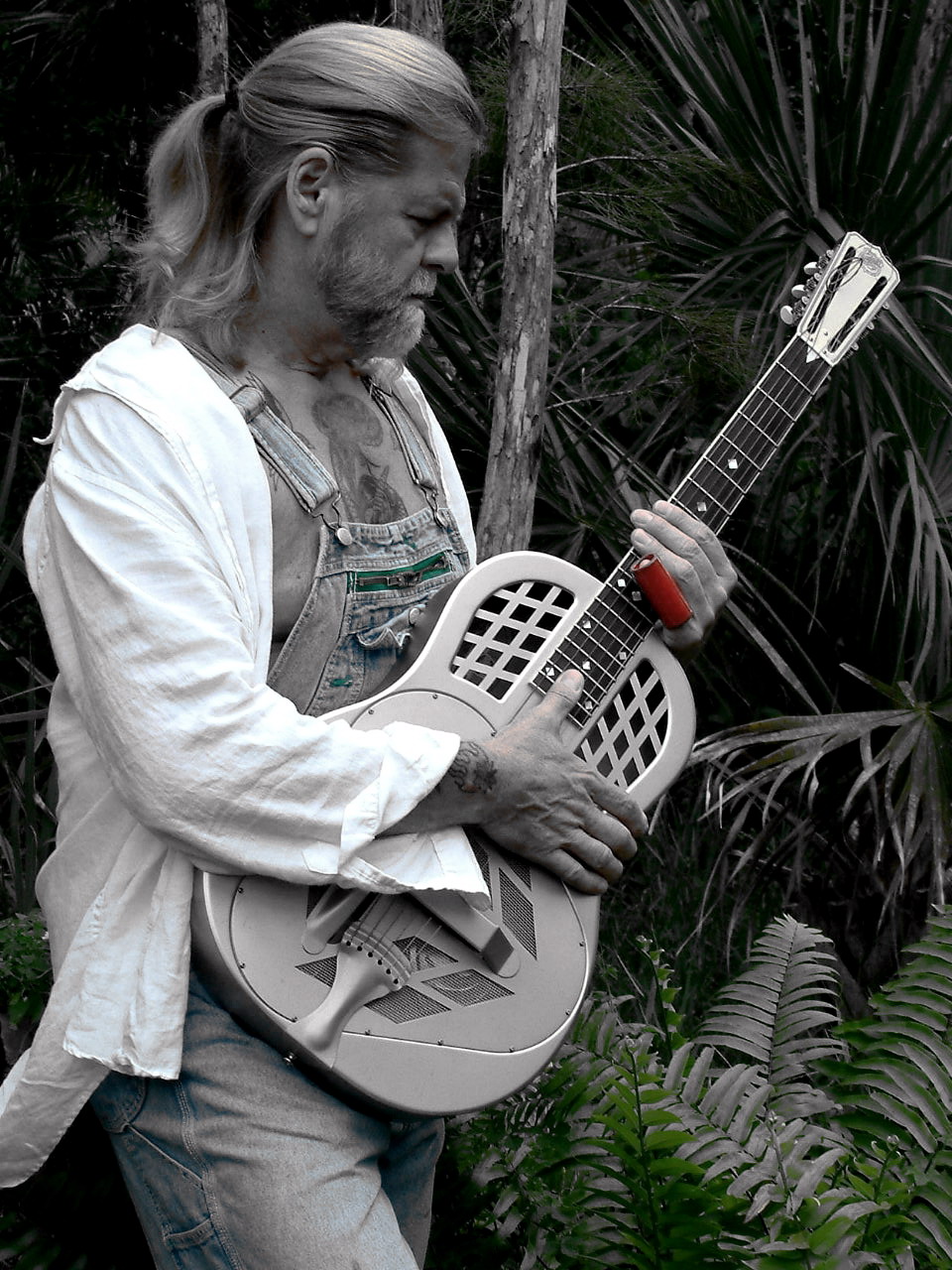
Bluesman-artist, Lennie Jones
As much as I was captured by the primitive blues art of bluesman, Lennie Jones, it was our conversation that pulled me in to fascinate. I became captivated by the full sweep of his life that found its way from the dark holler of a Virginia jail, to the sweat-filled isolation of experiences, as a law enforcement officer, when hunting down swamp rats in Florida’s Everglades.
His early life was fueled with a concoction of alcohol and an obsession with blues music. Both would reach deep into his soul, as one would take him to the edge, a place that rightfully can be called his “crossroads”.
His choice to crush the liquor demon would help transform him into the man he is today; a professional artist.
His life would have its crests and troughs, and all would be colorful; as colorful and as vibrant as his art. And it would be his art and his love of music that would eventually keep him alive and thriving.
Working with small canvases, he’d lay down portraits of blues legends in an array of explosive colors, soulful lines and sometimes haunting voodoo symbolism.
On canvas, Jones would capture the hip coolness of Hendrix, the essence of blue axe man, Johnny Winter, and the brooding and haunting life of Robert Johnson. His paintings often cast spells with rabid dogs, dragonflies, disarming grins or a murder of crows.
Jones would work his magic to support charitable causes, to build an art portfolio and to reach out to those who would appreciate and even love his visions of the blues.
Most recently the artist has partnered with Scream Guitars’ President, Kurt Kiehnle, to release a series of six custom pieces in a new Lennie Jones Collection. The guitars will feature Lennie’s portraits of Johnny Cash, Stevie Ray Vaughan, Jerry Garcia, Jimi Hendrix, Keith Richards and Robert Johnson.
A painting of a man gripping his banjo with a dragonfly resting on its skin was the piece that first captured my attention and one that cast a spell on me. I bought it and that led me to a conversation with its maker, the masterful artist, Lennie Jones.
******
Rick Landers: I understand that you’ve hung out in my neck of the woods.
Lennie Jones: I do know the area. I worked in Maryland for many years and spent a good part of my childhood in the Baltimore County area. I worked some in Northern Virginia and did a lot of fishing and that sort of thing up there. I’m just real familiar with that part of the world. I turned eighteen in jail in Baltimore County.
Rick: Are you familiar with the Birchmere and the old club called the Wax Museum?
Lennie Jones: I actually played the Birchmere once.
Rick: The old Birchmere, back in the ‘70s?
Lennie Jones: Yeah. Back in the ‘70s when the big band was The Seldom Scene. I was a fiddle player in a band called The Grim Pickers.
I got away from playing blues and rock stuff because I developed a serious alcohol issue, Rick, and I wrongly believed that getting into country music and bluegrass would eliminate access to alcohol and drugs. Boy, was I wrong.

Rick: Hey, did you know that Mike Auldridge passed away?
Lennie Jones: I didn’t know that. What a dobro patriarch he was, man. Jeez. I didn’t know that.
That’s terrible to hear. He was just a real pioneer, him and Jerry Douglas. I opened up for Jerry Douglas, Tony Rice and Ricky Skaggs back in a place called Wild Kingdom in Largo, Maryland. I believe it was Largo. It was a big entertainment facility, and those guys, they had their own band then.
It was prior to Ricky going country and everything and making a whole lot of money. Nobody really knew who Jerry Douglas was and J.D. Crowe was playing banjo.
And they had a serious rain that day and I stood in a parrot cage full of macaws with Ricky Skaggs. That was pretty amazing. Boone Creek was the name of the band then.
Bluegrass was just incredibly popular, and I played in a couple of different bands up there, after I quit playing the blues stuff.
For me, there’s never been but a very thin line between white blues and black blues. To me Hank Williams was a white Robert Johnson. It comes from the same origin. The only thing is they play in G, C and D instead of E, B and A.
I guess that’s a little bit simplistic, but I just love all that roots music.
Rick: Yes, this is a huge bluegrass area. People moved up from Galax to Northern Virginia and Delaware. Years ago I stopped in an antique shop and I picked up these old pictures from the ‘40s or early ‘50s, of country western singers and musicians playing in Delaware on an outdoor stage.
As I’m going through the album, I see Roy Rogers with Trigger. Trigger was rearing up on a small stage. I found one of the musicians who was in one or more of the photos and who is now elderly, and sent her the photos as a gift.
Lennie Jones: Unbelievable. All those guys would come to D.C. to make a few bucks, and we had some local people there. Back when I first started playing country music, Roy Clark was playing for Jimmy Dean over in the Bethesda area.
A friend of mine’s daddy played guitar with him. And Roy Clark already had a big reputation for two things.
I don’t want to sound negative, but he was supposed to be an incredibly lazy kid. And there was a place down on Howard Street in downtown Baltimore. Roy Clark would show up there once a month and have them change the strings on his guitar because he wouldn’t do it himself. [Rick laughing]
I can’t remember the name of the music store, but there were so many people in that area. In the D.C. area I met Bill Monroe. I met Muddy Waters.
Like I said, I opened up for a lot of well-known people including Canned Heat. And you could go out any night in the ‘60s and hear Emmy Lou Harris playing in Georgetown. Muddy Waters was at The Cellar Door. Canned Heat was at the Ambassador.
And then in Baltimore, all these little funky places would have John Mayall and. I paid three bucks, man, when I was a little kid.
I took a 25-cent bus ride down into the city from Baltimore County and saw Jimmy Reed open for The Temptations in a black movie theater. Me and another guy were the only white guys in there.
Rick: Was that the Howard Theatre?

“Primal Voodoo” by Lennie Jones
Lennie Jones: You know, it might have been the Howard. It was right up the street from the Civic Center, about two blocks away in a real rough neighborhood.
I remember Jimmy, and I actually played at the Baltimore Civic Center with my first band when I was 15 in the middle of the Baltimore Bullets basketball game at half-time!
Rick: I didn’t know you had that in-depth of a background in music. Did you know Danny Gatton?
Lennie Jones: I never knew Danny Gatton. I knew Frank Zappa. Gatton was playing at the Crossroads a lot down there with Roy Buchanan. I never got down there to hear those guys. I was so busy.
The band that I probably went to hear more than any that was current at that time and really loved was The Nighthawks.
Rick: Yeah, they’re still playing. They’re still around.
Lennie Jones: They’re still around. Mark Werner is still alive, and, of course, Thackery became the guitar hero.
At that time he played a Gibson Flying V and he sang a lot of Wolf’s stuff. Then they did some rockabilly stuff with Winter, and they were great guys, man. They were just nice fellas and they were really laying it down.
Back in the ‘60s, Rick, nobody really wanted for you to play blues. Zappa’s manager, Herb Collins, he really wanted the band I was in … by that time I’d been in a bunch of bands. It was called Urch Perch, and it was the most popular band in Maryland.
We had just played the march on the Pentagon, the first Million Man March and all that with Martin Luther King.
We played onstage while Norman Mailer spoke. And we were right there in front of the Pentagon and all these assholes started throwing rocks at the GIs. And I thought, “Boy, these are peace-oriented people?”
That’s the last protest I ever went to. But, at that time nobody wanted you to play blues. So, Zappa came and heard the band a bunch, and he liked it. He was a really unique guy. And he was living in Pimlico [Maryland] and he just started the Bizarre label. The only bands he had were the chicks out in California. I can’t remember their names. I’ll think of it.
Anyway, he took us to New York City and we played all over Greenwich Village and Colombia University and stuff. He lobbied to put us on his label, but we had a manager who owned a nightclub in Baltimore that was real famous called the Blues Set, and I didn’t have anywhere to live.
I was homeless when I was 17. My father had left many years prior and my mother had been married five times. She took off and went to Mexico.
I moved to a ghetto in Baltimore and Frank took me in. And I lived in a rock and roll nightclub. I was in the house band and then in the middle of the night it turned into a jazz club. Had a lot of jazz people come in..
I lived there and artwork on the walls and stuff in place of rent. Nils Lofgren played there every Sunday just about with Grin. I’m trying to think of the folk singer, who ended up becoming a radio disc jockey and a writer. He had one solo called “Jeopardy.”
Greg Kihn of the Greg Kihn Band. He’s a big deejay now in California and a writer and everything. He was a real nice guy.
Like I said, they had folk music on Sundays, but nobody wanted to hear a straight blues band. I started this band. I left one band to another to play blues. That was always my fundamental love. So you may get a kick out of this.
In 1967 they had my band open up for Canned Heat at this new place. It was kind of equivalent to Bill Graham’s Fillmore East, called the Ambassador. It was a huge.
It was one of them great big hippie things using massive speakers and everybody sits on the floor and we opened up. We opened up several nights for Canned Heat.
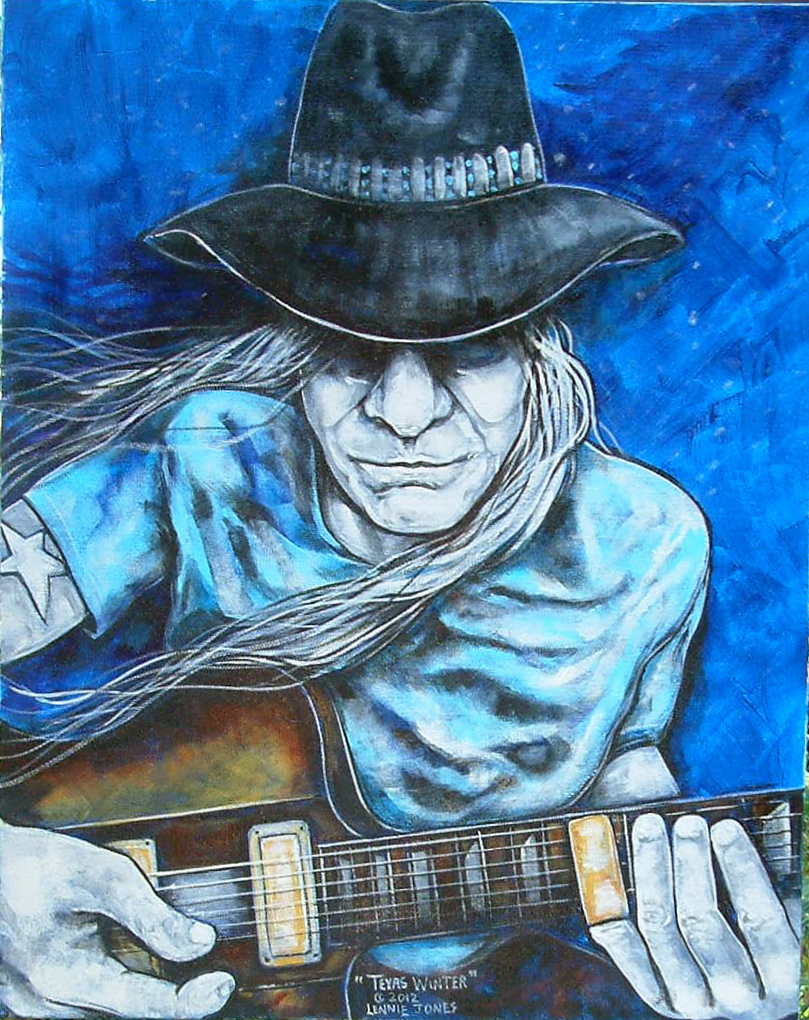
“Texas Winter” by Lennie Jones
Again, my manager constantly telling me, “You can’t do more than three blues songs in a set. Nobody wants to hear it.”
But they let me. I was a harp player then and I played bass. I’d been playing harp since I was a wee little kid. I was pretty good, you know? We opened up for them and the Bear [Bob Hite] came out from backstage with Blind Owl [Alan Wilson] and told me I was a really good harp player. Blind Al doesn’t talk.
Later I realized how intimidating that was to pull a harp out in front of Blind Al.
So, Canned Heat comes out there again, after me being told for years, with bands that I couldn’t play blues.
Canned Heat comes out with 22 amplifiers and cabinets. Some company in L.A. called TNT had sponsored them. They had just recorded their first album, and they come out there and Blind Al steps up to the microphone with a ’56 Les Paul with the P-90s, goldtop, opens up with Elmore James’ “Dust My Broom.”
I mean at volume 150 with all of them doing a head banger shuffle. I turned to my manager and said, “ I hope you’re seein’ this, man.” And they just blew me away.
They were just wonderful guys too. That was my first lesson that you really could make a few bucks playing blues.
Johnny [Winter] was playing, but he hadn’t really come on the scene yet. He didn’t really come around. When the first album came out, it got some airplay out in California. I was living in San Francisco then.
It was ‘68 or ‘67 late, and I can remember, you know. But anyway, I’ll tell you the truth, brother. I feel so privileged to have lived in a time when you could go out one night and hear The Byrds and then hear The Nighthawks a couple of nights later.
The diversity of string music was amazing. It was inspirational, and the other thing that’s so rough today is that I actually made good money playing in ‘67 and ’68.
I did a CD cover a couple of years ago for a guy in the American Idol Band, a phenomenal blues violinist named Jimbo Ross. And we were talking last year and he was telling me he was playing The Troubadour this one night and he was real happy with the cover I did and everything. I had a lot of respect for him as a musician.
He played American Idol, but really his love was blues. And he didn’t play that Jean-Luc Ponty crap with all the foot pedals. He played the real thing: hopped up, jacked up; Sugar Cane Harris on steroids. I’m sure you’re familiar with this pay-to-play thing, man. That just horrified me.
I just couldn’t believe that’s what live music with really good people has come to. Anyway, it’s a different world and I just feel really blessed to have grown up in that time.
Young people today with no music in the school in rural areas … my feeling is that the best music always comes from people who live marginally. You know, lots of kids don’t have guitars and stuff. So, I do a lot of charity stuff in that way, because I think it’s important.
Rick: Yeah, well, I don’t think we’re too far off as far as our ages. I’m from Detroit and remember going to the old Grande Ballroom seeing Cream and Frost.
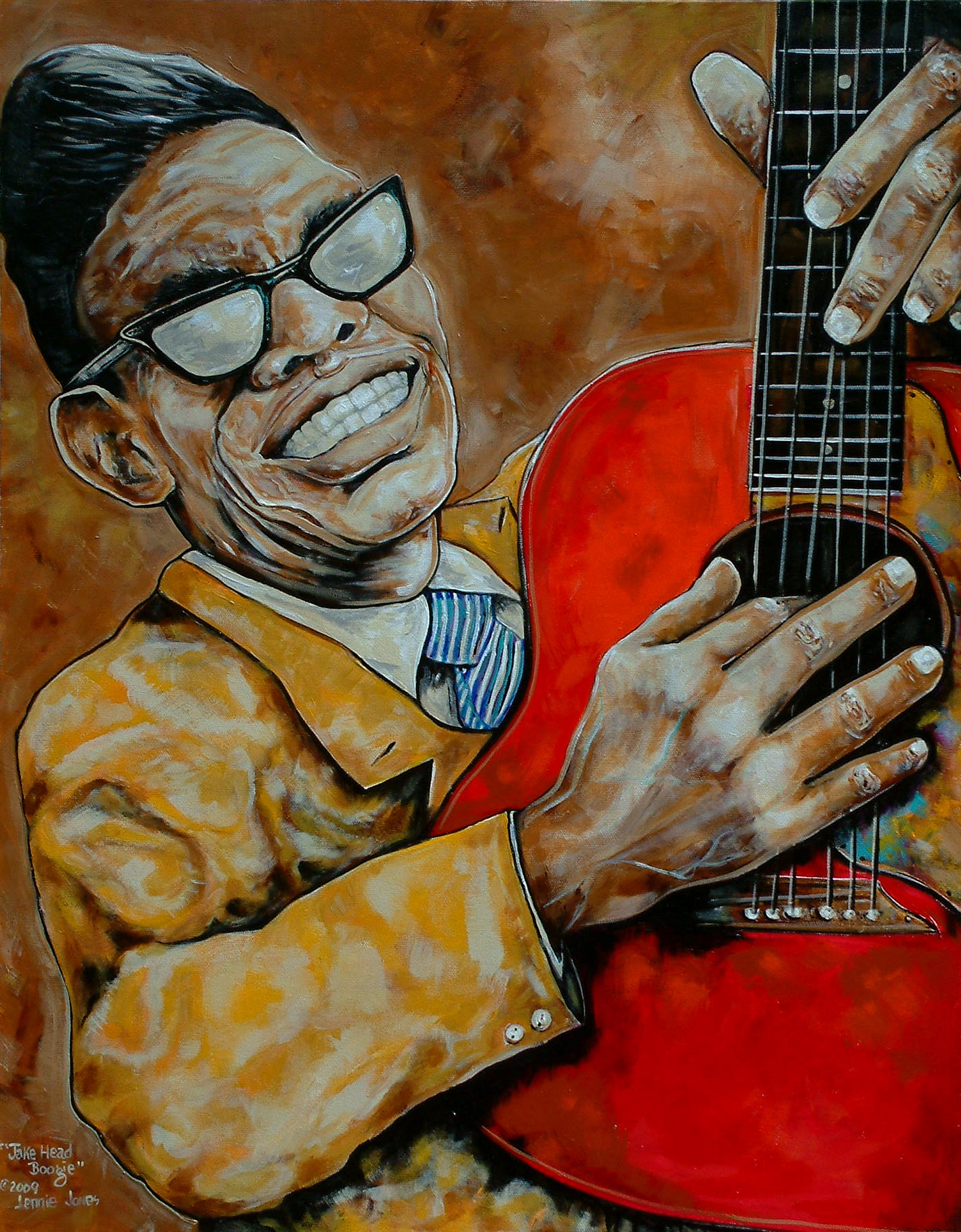
“Jake Head Boogie!” by Lennie Jones
Lennie Jones: You ever see John Lee Hooker down there on Haitian Street?
Rick: I saw John Lee Hooker at the Ann Arbor Blues Festival in the early ‘70s.
Lennie Jones: No kidding? I’d love to have seen him.
We had a friend of ours over here at Thanksgiving, George Mitchell. He was a pioneer recording blues musician in the early ‘60s, primarily in the Mississippi hill country.
Then he moved to Chicago and opened up a little blues and folk night club. He worked for Delmar Records, for Bob Castor.
He opened up a little pub thing with Mike Bloomfield, who was his roommate. Yeah, he was sitting there eating Thanksgiving dinner talking about when John Lee Hooker came to his house and his mama fried chicken for him [Both laugh] and I thought, that’s a real blessing there.
Rick: Yeah, it’s amazing. It sounds like you were pretty immersed in the scene. I was just the kind of guy who went and saw the shows. I could play guitar, but I wasn’t in any real working band.
Lennie Jones: It doesn’t matter.
Rick: But, I loved guitar, loved music.
Lennie Jones: And what would you do without a guitar? You know what I mean?
I quit playing music publicly when I got sober. I play every day and music is still one of the most critical elements in my life. I think I drive my wife crazy playing guitar sometimes.
Rick: I have a bunch of guitars. I have one in my living room. In the morning sometimes – a lot of times – when my wife is reading the newspaper, I grab my guitar and fiddle around writing songs. [Laughter]
Lennie Jones: Isn’t that something? There’s no replacement for that. And it’s the same with kids, man.
I mean, I’d have got in a lot of trouble as a young‘un, but I’d have got in a lot more trouble without that. I’ll tell you that. I got so much into the blues thing.
Then the Stones first came out and started making money with blues. My granddad was extremely conservative, but he took me to a music store and bought me a $68 Harmony vintage Sunburst bass, then went in his shop and made me a black leather vest. He was my hero.
Then I got a rock and roll band.
Rick: The first band I was in was a garage band and I had a Silvertone guitar and Gretsch amp. The first Stratocaster I saw live was when our lead guitarist, Tom Selon, came in one day. It was beautiful and I was pretty jealous!
Lennie Jones: A Silvertone amp, man, that’s what I had.
Rick: You have the two 12-inch speaker ones?
Lennie Jones: That’s exactly what I had. And I played a cheap bass then. It wasn’t even a bass amp and it sounded good.
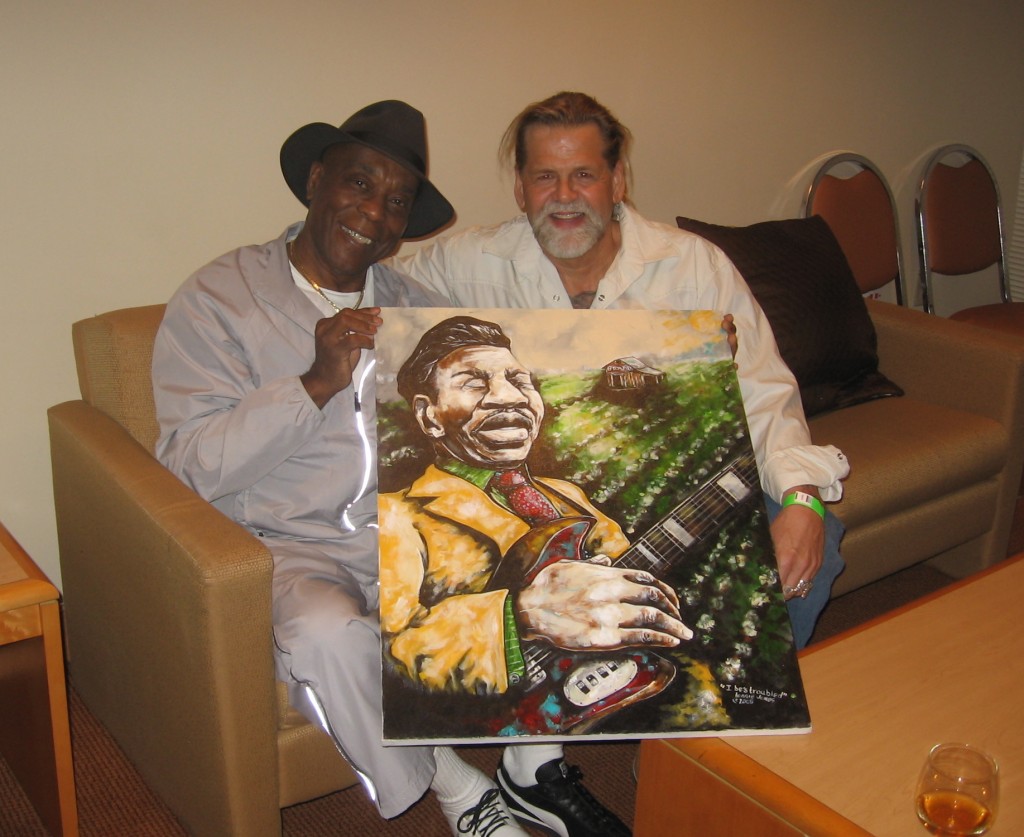
Hall of Fame blues legend, Buddy Guy, with Lennie Jones
Rick: Most of your art appears to be about rural America with an emphasis on the blues musicians. How did that come together?
Lennie Jones: I’d like to give you some intellectual, articulate answer to that, but I was just primarily raised up in that Maryland area. My family was from Florida on one side and Louisiana on the other.
I was always exposed to music from that part of the world. And my dad was from Baton Rouge, and he was a drummer, and he worked in the General Motors plant.
He had a lot of black friends and he listened to a lot of black music. He loved jazz and he listened to Jimmy Smith a lot, who was very bluesy. He turned me on to B.B. and Albert King. That just kind of changed my life.
Later in life I discovered the roots of country stuff and the similarities in it.
I was playing bluegrass. I got to meet Bill Monroe and all. Hank Williams and Bill Monroe learned how to play music from black blues guitar players.
And during the same period, everybody was coming to your area back in the ‘40s and early ‘50s.
From the south all the black guys were going to Chicago or Detroit to work in factories and play their music, the same thing that’s happened in the Appalachians.
Like I said, just with G, C and D chords. I love both forms of music, and I guess that folks that live on the edge like that always seemed to make a joyful noise to me. My father was also a pretty good artist and so was my mother.
I started out as a teenager paying my rent by doing psychedelic stuff on the walls and all. I moved to California when I was 18, and moved to California and went to the Fillmore West a lot.
I actually went and met Bill Graham and tried to do posters for him, but he had Stanley Mouse and Rick Griffin. He didn’t need Lennie Jones.
Everybody used to rap bad on him, but he spent an hour with me as a kid and he was really nice to me.
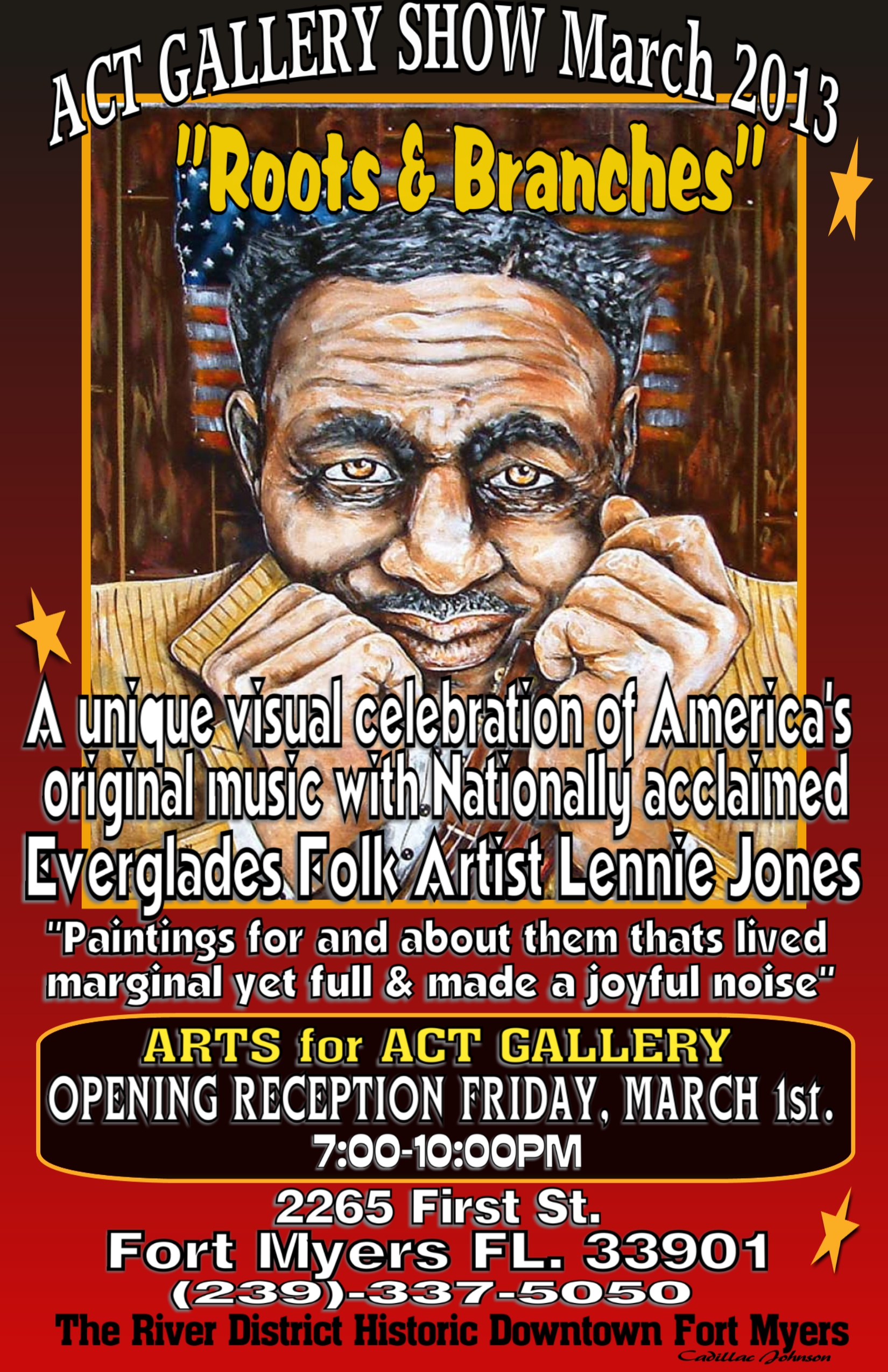
ACT Gallery 2013 Poster – By Lennie Jones
Rick: I’ve heard some good things about Bill Graham, lately. Did you know Paul Olsen?
Lennie Jones: I did not.
Rick: Paul did a lot of posters in San Francisco back then, as well.
Lennie Jones: The name sure sounds familiar, and I never met any of those artists. Of course, I really admired them.
I quickly discovered that making a living playing music and doing art wasn’t gonna be a good thing for me. I had an art scholarship, but I had this thing going with Zappa and I thought we were going to make a lot of money. I never used the scholarship and I probably wouldn’t have wanted to anyway.
But, that very sporadic income and the lifestyle, I started drinking real young, partying and took acid before it was illegal.
I ended up getting a regular job. The main thing about that component that really always bothered me, Rick, with art or with music, they always wanted you to do something you don’t want to do.
I didn’t want to end up being middle-aged at Ramada Inn, you know, playing , singing some goofball song off the radio or doing “Proud Mary” all night.
Rick: Doing covers.
Lennie Jones: Yeah, so I waited thirty years to paint, and now I get to paint every day, and my wife handles a lot of my contact stuff with people.
So I’m pretty free to be creative. It’s a real blessing. I paint literally every day. I get up at three in the morning. I paint before sunup. I love to do it. I’m driven to do it.
And I’ve never had any lessons or anything. I try to be a true folk artist. I don’t do prints or t-shirts and that sort of thing. Everything I sell – for better or worse, [Laughing] has got my touch on it.
Rick: They look good. You know, that’s why I picked up that banjo piece.
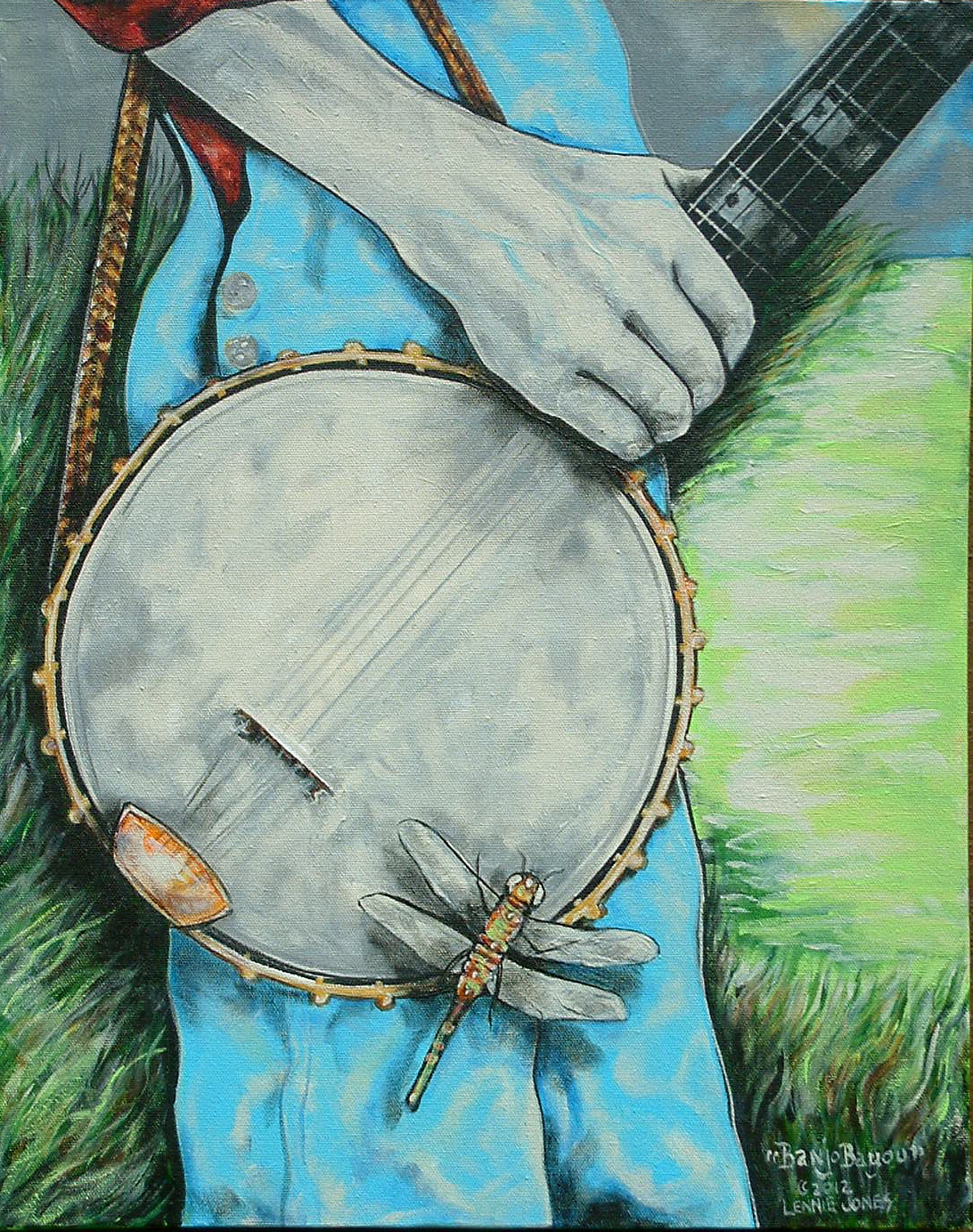
“Banjo Bayou” by Lennie Jones
Lennie Jones: Thank you. I sure appreciate it. Yeah, that’s one of my favorite pieces, actually.
Rick: Yeah, I love that. I haven’t hung it yet. I’ve got it in my basement, sitting so I can put the light on it and look at it and figure out where I want to put it, but I need to get my wife’s permission no matter what.
And I like the dobro painting.
Lennie Jones: Well, the story of that piece is it’s supposed to be kind of a convict-type guy. “Ain’t No Secret” is the title of it, but it comes from an old jail saying that says, “Ain’t no secret. You got nothing coming.”
And that’s the story on that. He’s just laughing about it, and, of course, he’s got a National Tricone, one of my favorite guitars.
Rick: Yeah, those are pretty cool.
Lennie Jones: It’s nothing deep. It’s just an old convict thing. He’s laughing about it. He’s always talking to a young musician who has no experience with anything who has these great expectations, maybe asking an older guy, “How come you never made it?”
I met Honeyboy Edwards once and asked him about ending up in Memphis and Detroit and everywhere, but Chicago. It’s just that attitude of, “Why didn’t you ever really make it when the other guys made it?” That’s what I kind of had in mind.
Rick: Most of your paintings seem to have these characters in them and you get the feeling that there’s some background story going around.
Lennie Jones: There always is.
A lot of them are personal experiences. Some of them are just song lyrics that have always really, really inspired me. I just relate to a lot of the guys.
I got to meet Muddy Waters. I always wanted to paint Muddy Waters. He just had this aura about him that was unique.
Actually, I did a portrait of him real serious on Stovall Plantation, but with his guitar – his old Guild Thunderbird from his days doing the hopped-up stuff for Marshall Chess after Leonard Chess turned all that stuff over to Marshall. Stuff he didn’t like, you know. And I did that for Buddy Guy, and he really liked it.
I can’t think of any that have a particular intriguing story.
I did a painting of Robert Johnson with a wild horse running by him one time. Robert Johnson’s grandson contacted me. After Clapton did that album and did so well in 2004, I had just got modern and got a telephone that had caller ID on it. I got this phone call – it came up “Robert Johnson.” And I’m sitting there painting and I go, “Holy hell! What the hell is this now?”
Rick: From the grave…
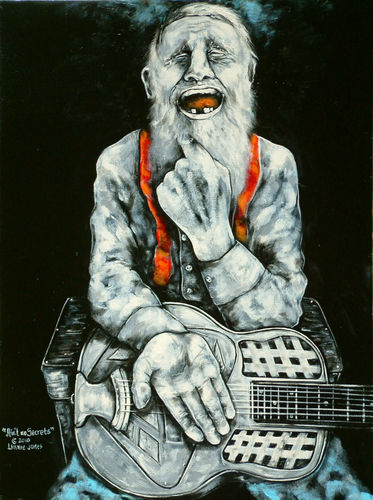
“Ain’t no Secret” by Lennie Jones
Lennie Jones: I picked it up and I hear this deep voice and if you’ve ever met Steven Johnson, his grandson, he’s a mountain.
And he says, uh, “Hey, this Lennie Jones?”
I said, “Yes sir.”
“Steven Johnson, I’m Robert Johnson’s grandson.”
“Damn, brother,” I said. “Robert Johnson,” I said, “you scared me!”
“Uh huh, I come back to get you!”
“That’s right – out on Highway 49.” And he started laughing. They brought me to Mississippi for the Robert Johnson Museum. I wouldn’t let them pay for me to come there. That was a real honor for me to do a painting of him and some prints and stuff.
First time I ever did prints, and last time, but in honor of him, I was happy to go out there and put stuff in the museum and everything. They got a lot of money when they won the genetic lawsuit thing.
I know that Eric [Clapton] gave them a lot on copyright stuff and all. I ended up meeting the guy, an ex-CEO of Arista Records there and I had a long-term relationship with him.
He collected my artwork. He had the “Robert Johnson Songbook” copyright at that time, which has since been sold.
But that’s a good story. Let me tell you another one real quick.
Willie King was somebody I really admired, and I loved his music, especially when he came out with . . . gosh, what’s the one CD where he . . was with Willie King and the Liberators?
He started winning a Grammy and everything and we kind of got hooked up over the years. He liked my artwork and he just did a huge amount of stuff for the community and everything.
The University of Alabama had this thing on Southern writers and musicians and that sort of thing. It was a forum for graduate students and staff. Willie King and I were there on the same night. That’s the first time I had a chance to meet him.
And I got to get up in front of the whole school there and do this thing about my wonderful art and my history, and blah, blah, blah . . . what a weird character I am. I had all these paintings on easels, but I had one covered – I had done a portrait of him.
Rick: Had he not seen it yet?
Lennie Jones: He’d never seen it. And it was a gift. And I had him come up and unveil it and he just cried. He was an amazing guy. I hate that he’s gone.
Rick: They’re all kind of going, you know?
Lennie Jones: Yeah, they sure are, but my wife and called him the Blues Buddha. He had a vibe about him, but he was crying, leaned on my neck and whispered in my ear, “Man, you know you ain’t no white man.”
That’s what he told me. And then I met Buddy Guy in Miami. I got to present him with that Muddy Waters portrait. He got a tear in his eye and started telling these old stories about Theresa’s Lounge. It was just magic to me.
Like you said, they’re all going. He’s really the last living link to the old-school guys to me. Even the young fellas – we loved Michael Burks. I got to hook up with him many times, and he was such a wonderful young fella. Just could play, and now he’s gone.
Rick: Who’s the guy from back in the ‘60s – he might have died back in the 60s or 70s – Magic Sam?

“San Antonio Bound” by Lennie Jones
Lennie Jones: Yeah, Magic Sam Blues Band out of West Chicago.
He was good and a lot of young guys were really turned onto him early.
There’s a new CD coming of my favorite harmonica player, Charlie Musselwhite playing with Ben Harper, of all people. Musselwhite, he was a tough guy, and he hung out in Chicago in black bars and carried a piece and everything.
He’s good friends with George Mitchell, and I’ve heard a lot of stories. He’s the reason I wanted to learn to play harmonica. I had this album called Stand Back, with Harvey “The Snake” Mandell on guitar and him on harp. Man, it was amazing.
Rick: I’ve been trying to find someone who gives lessons in harp around here, and there’s just nobody.
Lennie Jones: Yeah. Gotta learn it yourself, brother.
Rick: Yeah, I guess I’ll have to do that. I’m so busy writing stuff.
Lennie Jones: Oh, I know you’re a busy guy. I play several instruments and I started with that. And I went out and made money with it. I never considered myself to be a great musician, but I could play what I heard in my head well.
And that’s the thing about being self-taught. As far as music theory or knowing what the hell I’m playing in or half the time what key I was in, I didn’t know it.
Rick: I just picked up guitar and figured it out for myself. I made up my own fingerpicking style.
Lennie Jones: Yeah! And it’s kind of a Zen thing too. It’s a soulful thing
You don’t have to be good at the guitar to make it a major part of your life. I know people who play the same three chords over and over and sing, and it brings them a tremendous amount of joy. That’s the magic and the Zen of a guitar.
Rick: Yeah, I’ve heard, “it’s easy to play a guitar, but it’s hard to play it well.”
Lennie Jones: That’s right. And if you learn those basics, you can really have a heck of a lot of fun with it.
Rick: Yeah, you sure can. From what I’ve read, your life hit rock bottom at some point and you were able to get a better footing.
Lennie Jones: What got me to where I was, was many years of drinking,
When I started playing in bands, I was just a young teenager back then. They always said, “Well, we can’t pay y’all what you’re worth, so drink all you want.”
And I did. I came from a long line of heavy drinkers. I started when I was around thirteen and by the time I was a teenager, I was pretty strung out on alcohol.
I would take anything to get me more high, once I was drunk. But, I was never a drug guy. I’m not saying I was better.
Alcohol’s a narcotic drug, but I stayed drunk. And I tried to get sober a couple of times, and I had moved way down in the mountains in Southern Virginia and was gonna stay away from music. And I was trapping fur and living way back in a cabin, alone and doing artwork.
Three months out of the year I worked for the Game Commission, catching fish for rookeries and hatcheries.
I got back into music, I started playing fiddle, electric fiddle, with a country rock band and started drinking. You know, same old crap.
March 16, 1980, I got thrown in jail, and I hadn’t been in jail in a good, long while. And I was kind of well known for being a fiddle player. I had been in the paper and on TV and stuff.
They put me in this little country jail chained to a black murderer. They’d put me in a black cell block. I got in front of a judge, and I was looking at one to three years in state prison, because I had so many alcohol-related charges from the time I was a juvenile.
You know, drunk driving, public intoxication – no felonies or nothing like that but all relative to drinking. I got out of jail that next morning, instead of giving me one to three, I was real candid with him.
My blood alcohol was .23. Almost 25% of my blood was alcohol. And I don’t want to sound corny, but I went back to my cabin in the mountains in front of the woodstove, and got down on my knees and prayed to God to get me past this addiction.
I’d been twice in AA when I lived in a more developed area and once for a year and a half, but I couldn’t keep it. And I couldn’t keep it when I played music. The temptations were just too much. Never drank again.
That put me on the right path. That was my crossroads for real, and I know that sounds corny, but eventually, later on down the line, I had worked earlier for the U.S. Fish and Wildlife Service. I went back to work for them, and eventually they had me out catching poachers and wanted to send me to the Federal Law Enforcement Academy to be a federal agent in the woods.
I went through the whole interview process. I was real candid about my juvenile years. They couldn’t really discredit me because I was honest about it, and I had totally quit drinking. Never had any felonies or anything. I don’t think a young man today would ever get the same opportunity I got.
Rick: Yeah, maybe not.
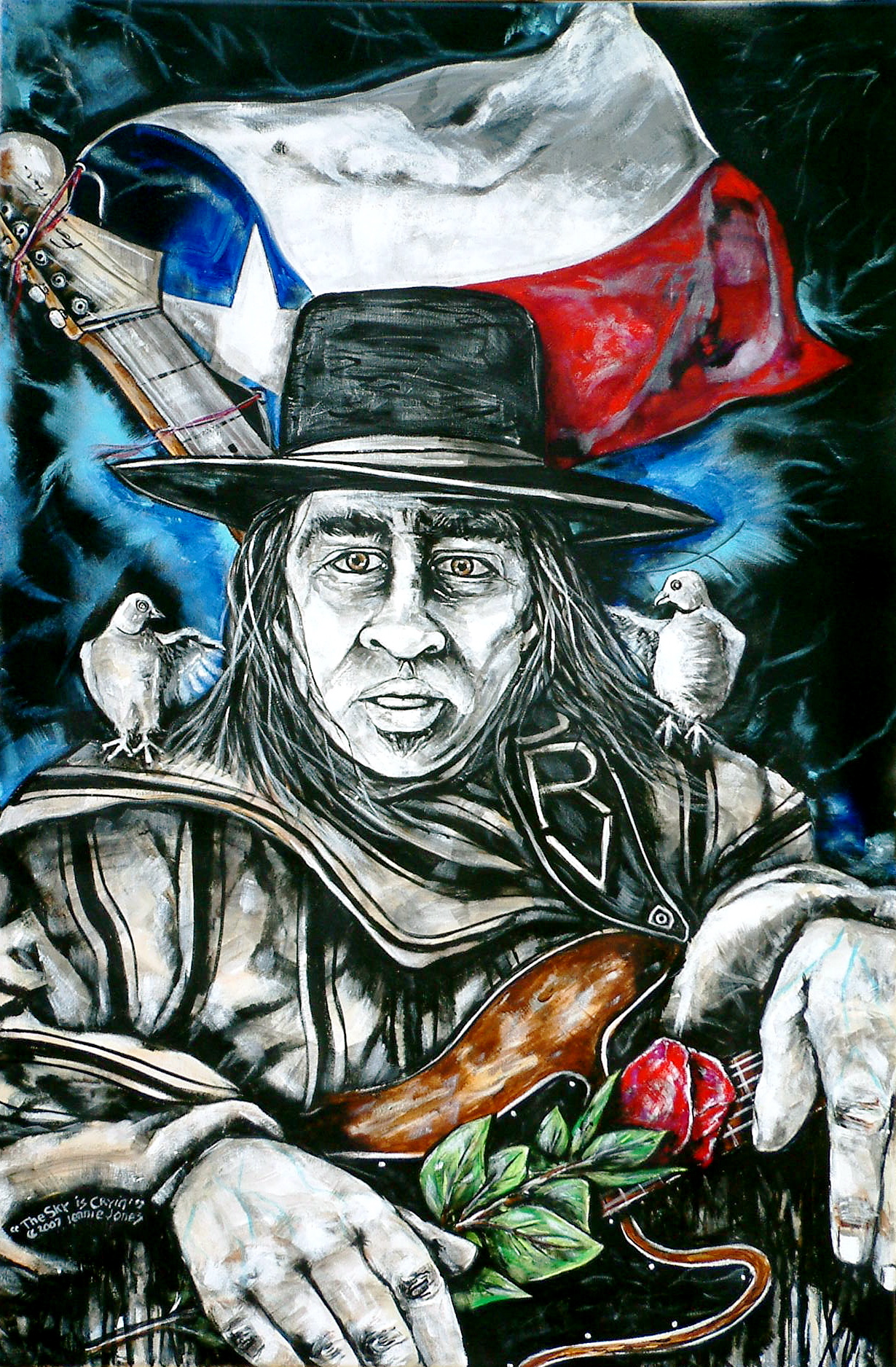
“Sky is Cryin'” – by Lennie Jones
Lennie Jones: You know, it’s the way things are so pragmatic now. At any rate, I went to the Federal Academy. I was one of the oldest students, and I did really, really well and came back two years later as part-time instructor.
I went to the Everglades, which I always loved and had visited the area as a kid. I worked 20 years in the Everglades, basically doing everything from – primarily beating up rednecks and arresting poachers and smugglers. I also did a lot of wildlife stuff , like tagging panthers, crocodiles and alligators, that kind of thing.
Rick: Did you ever do anything with manatees down in southern Florida?
Lennie Jones: Yes, did a lot of enforcement stuff with manatees. Not only on the water but also in the exchange of their ribs and stuff. Redneck ivory.
Rick: Really? I didn’t know that.
Lennie Jones: Yeah, there’s a huge market for that, especially with Vietnamese.
Everything’s for sale down here. I did a lot of teaching. I taught all over the country, in different colleges, wildlife survival skills – never been to college.
A lot of different law enforcement agencies had to live in the woods – different threats in the woods, intuitive survival skills with bad guys and that kind of stuff. After 9/11, they made me a U.S. Marshal for the final five years of my career and I body guarded politicians and places that had been threatened by terrorists, and that sort of thing.
Rick: Well, you’ve really done well given the background that you had to get into law enforcement.
Lennie Jones: Yeah, man, it was an incredible blessing to go from turning 18 in jail, literally to bodyguarding two presidents. I bodyguarded George Bush some and I bodyguarded Jimmy Carter some, when he’d come down here, in addition to a lot of lesser-knowns.
Yeah, it’s phenomenal, man. And, again, it sounds kind of trite, Rick, but only in America. That would not happen anywhere else.
I had been in the woods all my life, really, and stayed in the swamp, coming to Florida, going to Louisiana. My father – one of several good things he did for me was he took me to the woods all the time. He used to drop me off there and come pick me up at dark.
I loved being in the woods, so I was a prime candidate to work alone. I worked alone for the first 13 years in there. Chasing bad guys. I was really cut out for it. I don’t think there were a lot of people who wanted to do it. I don’t know.
Rick: It’s dangerous work.
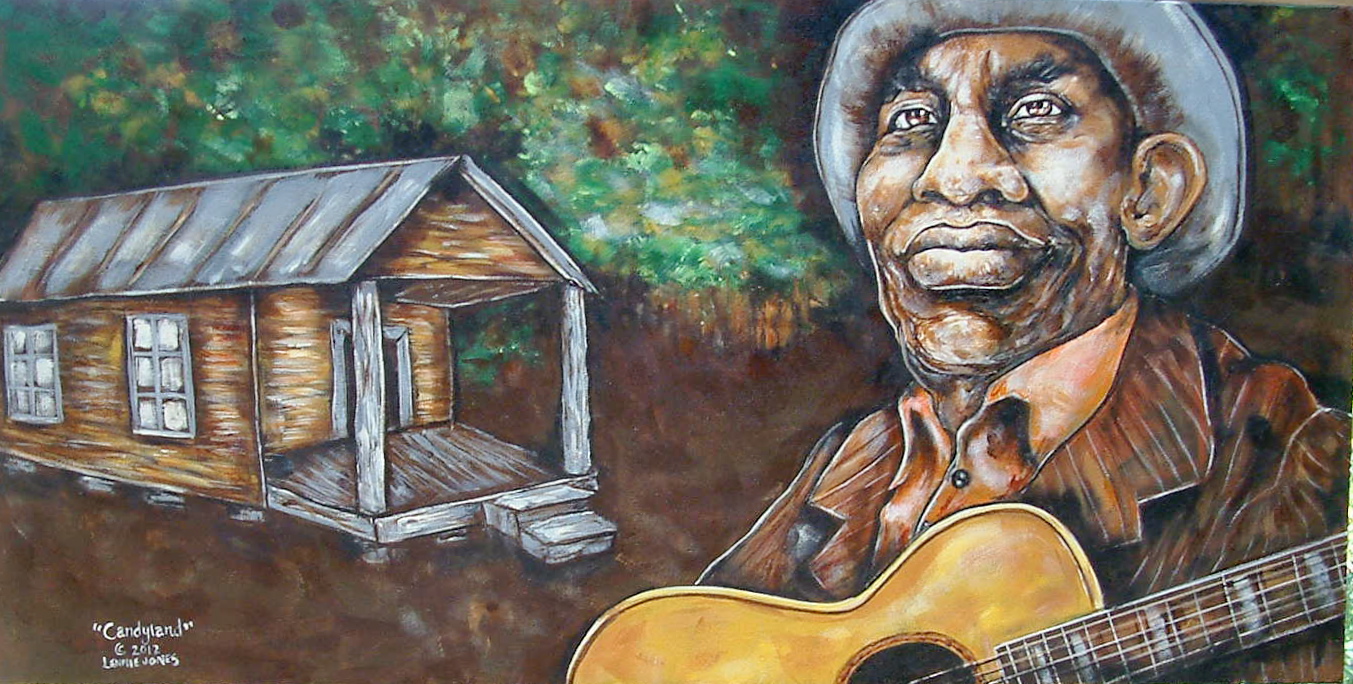
“Candy Land” by Lennie Jones
Lennie Jones: Yeah, it was dangerous, but I didn’t see it that way. I just had a wonderful career, and it was a kind of 24/7 thing – probably like managing a magazine.
Until I retired in 2006, I illustrated some manuals and that sort of thing.
But, the creative side of my art that I really wanted to explore and do the music thing with it, I waited ‘till I retired.
When the Secret Service would come down here with the president, they didn’t want to be out in the swamp with Jimmy Carter. Man, he’s 83 years old. We’re standing in waist-deep water, taking a leak together. I mean, that guy – alligators swimming all around, moccasins sunning on logs . . . he’s just happy as he can be.
Rick: Did you ever paint for people on a commission basis?
Lennie Jones: I typically do not. I’ll tell you of a couple of rare exceptions. All the things I’ve done that have been reproduced, I don’t reproduce any. I don’t do prints, t-shirts, and all that kind of stuff.
I just feel like it’s wrong for what I’m trying to do.
But, for instance, Steve Gumble ,who runs the Telluride Blues Festival, he loves my work, and he’ll see all the new images I’ve done in a given period of time. If he sees something he likes, I may modify it and make it specific to Telluride. But typically, him and people I’ve done CD covers for will take art that I’ve already done, have a graphic designer overlay stuff for it and everything else.
I just really want to paint what I want to paint. In my head, I waited 30 years to do this. My head is so full of song lyrics, images, personal experiences and things that I just want to do what I want to do.
I’m a spoiled son of a bitch and I’ve got a little chicken shit retirement and my wife’s got a little job and she not a money gal. She’s like me; she’s a music lover and we have a real simple existence. So I’m blessed to have the freedom to do what I want to do.
Now recently I did a piece – I don’t know if you know who Anders Osborne is . . .
Rick: Anders Osborne? Not offhand, no.
Lennie Jones: He’s a guitar player from New Orleans and a songwriter. We’ve had a real similar life and I’ve been listening to him for about 15 years. You should check him out.
He came from Norway or Sweden 25 or 26 years ago, went to New Orleans and became a real respected component of the New Orleans music scene, which is really difficult anywhere in the South. You’re from somewhere else, I mean, to break into that inner sanctum is pretty tough.
I did the Telluride Blues Festival. I did all the art for it, and I’m the only artist, by the way – this is a little bit of ego here – who’s ever been invited back. I’ve gone three times now. It’s the best festival I’ve ever been to in my whole life. My wife and I just love going there. They treat you with real respect.
You know you’re sitting backstage eating, watching John Hiatt look for a fork and knife to eat with and fumble around and talking to Chris Robinson about doing some art for the Black Crowes while we’re ordering omelets.
It’s really cool, but anyway, Anders was there. I really wanted to hear him and Tab Benoit and the Lee boys.
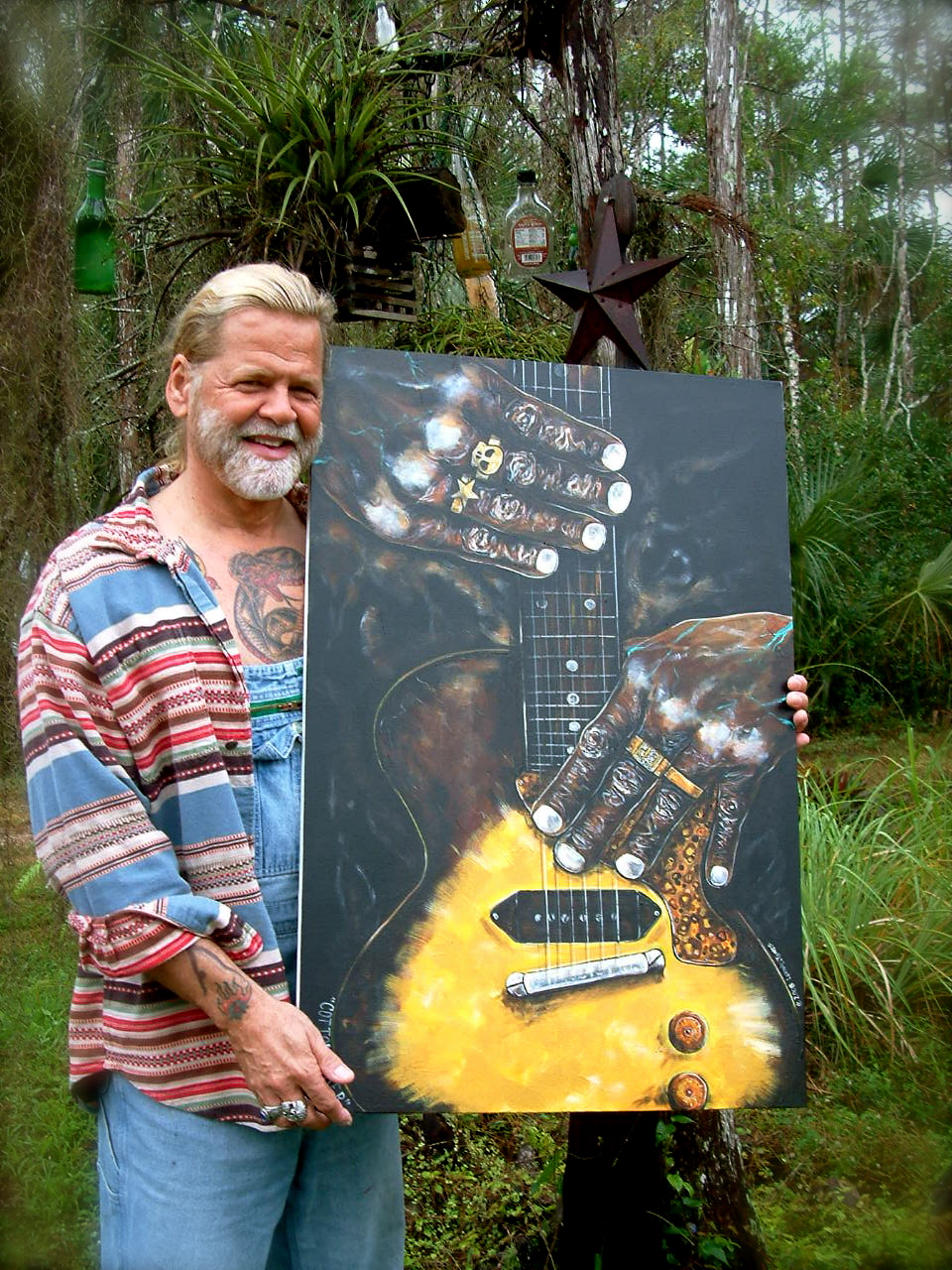
Lennie Jones
So, the next day we were on top of this mountain lodge where we were staying, and when I came out, my wife said Anders had just walked by.
I never had met him, and I’m not a groupie-type dude. But, we went up to get a coffee and he was standing. We started talking and we kind of hit it off. Later on I wrote for some of his band members. They really liked my art.
We both had gotten sober. His management company contacted me and asked me to do a portrait of Anders. And I said, “Well, I typically don’t like to do that,” and they said, “Well, he really wants it. We’re building a website, blah, blah, blah.” He had just gotten a Grammy for a song he wrote for country artist Tim McGraw.
Rick: Oh, yeah.
Lennie Jones: I really admire the guy, really respect him, so I put a bunch of his music on for a week on the CD player, record player, and I did a painting of him.
They gave me total freedom. Anders said he wanted me to do it. I told him to look at my work. It’s a little unusual. I’m self-taught and I don’t do photorealism or any of that sort of thing. I try to capture the essence of a musician, their music and everything and I listen to them when I’m painting.
Anyway, I did it and they were real happy with it. That just happened. So I do stuff like that occasionally, but it’s got to be the right person. And I have to respect them. I don’t really have to like their music. It’s critical on some things and not so critical on others. If I respect them, I enjoy them. I’m pretty spoiled.
I wanted to tell you why I had to cancel this interview the other day. I think you’ll be interested in this.
Rick: Yeah?
Lennie Jones: There’s an ex-musician that moved down here from New York City. He’s the marketing director for a large TV station, and he had walked into a gallery down here that shows my work. It’s a benefit art gallery for battered women and it’s real well known.
He really liked my work and contacted me about using a copyright extension to put some of my paintings on guitars. He started a company called Scream Guitars.
They got all this licensing to do Hooters and Budweiser and that sort of junk on basically Fender Squire design. And to make a long story short, I had a meeting with him that day, preplanned. Like I said, I don’t like my artwork reproduced in any fashion. I think the commercialization of it like that is not right, but he’s actually gonna make inexpensive guitars and he has a good sales base with my paintings on there.
Kids can have their guitar heroes on the guitar or hanging on the wall as a decoration. And the guitars actually sound decent. Primarily Strat and Tele copies.
The first one’s gonna come out in a couple of weeks. But it’s a Jerry Garcia Strat, and I’ll have to send you a picture of it. It really looks good.
Rick: Yeah, I’ll look forward to seeing what they come up with. The Jerry Garcia one sounds pretty interesting.
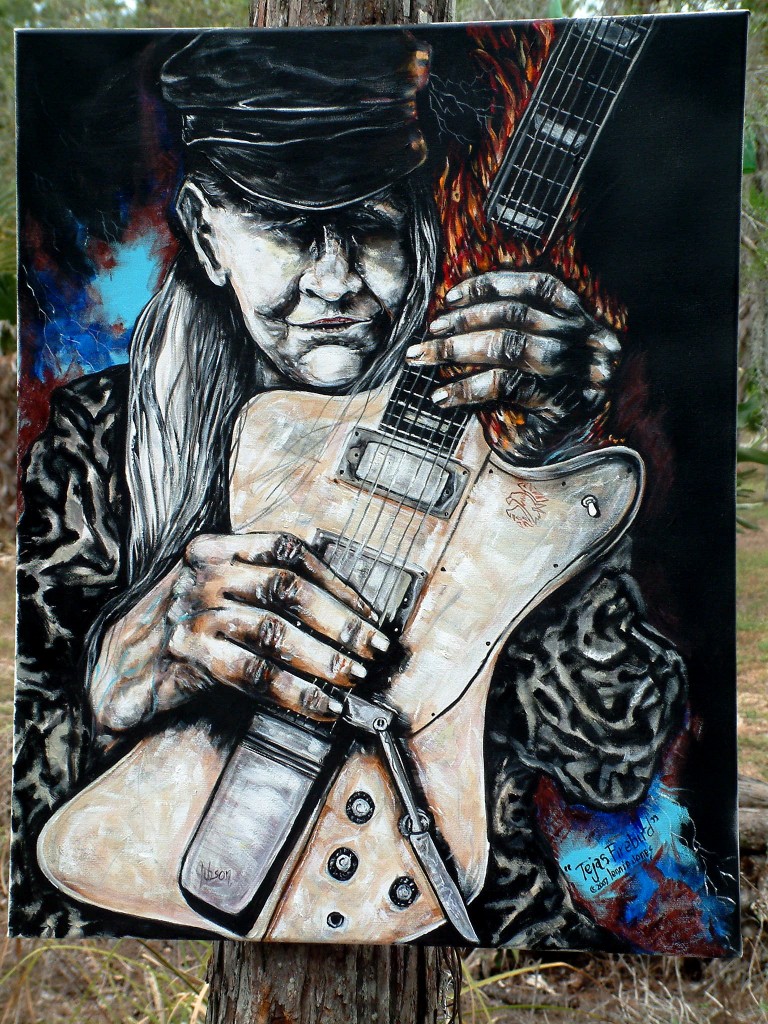
“Tejas Firebird” by Lennie Jones
Lennie Jones: I’ve done portraits of everyone. I just finished Johnny Winter. I just finished a Hendrix one that’s in a gallery in Woodstock right now. But in the past month I’ve done Johnny Winter, Hendrix, Hank Williams, Son House, R.L. Burnside, Johnny Cash, Gatemouth Brown in recent months, and Patsy Cline, man, John Hurt. I like all that music and I love doing portraits of those folks.
Rick: Do you ever do large pieces?
Lennie Jones: I don’t do the bigger pieces. I’ve got so much creativity and stuff that I want to do, that doing those large pieces, one, most people who really appreciate the art don’t have room for large pieces. Two, they take so long. I like the chance to move from one creative project to another.
You know, talking about these musicians, I just want to tell you this real quick. I think you’d appreciate this. I had a blues musician in Alabama named Bruce Andrews, and he’s also an artist and a phenomenal harp player.
He’s got a band called 2 Blu and the Lucky Stiffs. And they’re real big in the Birmingham area. And they played International Blues Challenge on Beale Street and come in second or third every year and anyway, he had been in love with my work for years and I had donated guitars and art and everything to the Alabama Blues Project.
Willie King was a co-founder of that. They take all these rural children that don’t have anything, and they give them guitars and instruments and they teach them how to make a blues CD during the course of a year.
Rick: Really? That’s cool.
Lennie Jones: Yeah, and that’s amazing, so on behalf of the Shelby County Arts Council there in Birmingham, Alabama, they wanted me to come up and be featured at this art show.
I went up there and when they looked at my bizarre background, they asked me to teach at what they a juvenile detention center; it’s really a juvenile prison.
You know in Alabama, the kids get caught smoking a joint or if they murder somebody, they go to the same place. And then when they’re 18 they turn them out, you know? They put them in the big house or they send them home with a house arrest, or whatever.
So they asked me to teach there and I said, “Man, you know I’d love to do that.” So I got to go up there with these young people and I’m gonna continue doing it every year.
What I want to tell you was I taught them an art class. They had canvases there and acrylic paints and I told them to paint with their weak hand. And I told them they could give me the finger, they could give me gang signs or anything else.
But, I want them to understand the choices you make with your hands and how critical that is to the rest of your life.
And as an example of that I used Robert Johnson. I brought a portrait of Robert Johnson I had done, and I talked about the choices you make in your life. You know, who you hang around with, but I’ve been using musicians for that.
This year I’m using Hank Williams and Leadbelly. And the kids just loved it, man, loved the musical history. I’m also donating a library of blues books; over 120 blues books to them to read about America’s original music.
I mean, I’ve got books on everybody from Johnny Cash to Howling Wolf. I thought you might be interested in that. Music has an amazing redemptive quality to it as you know. The kids were really enthralled with these stories about these musicians. Robert Johnson is such a fascinating guy.
Rick: He was shot and killed by some woman’s husband, right?
Lennie Jones: Poisoned. Poisoned in 1937, and Honeyboy Edwards was there. And that’s what gave rise to the devil thing because he put strychnine in his whiskey jar.
When he went out during intermission, he got down on all fours and was howling and shooting white foam out of his mouth. But, Robert was an amazing guitar player.
Honeyboy saw a portrait I did of Robert and he said, “Man, you done that, man? That’s good!” That made my life right there. Just hearing that. I got that quote on my website. I’m sure people think I made it up, but it’s true.
Rick: What projects do you have going on at the moment?
Lennie Jones: I just finished a Keith Richards portrait, a Hendrix portrait and a guy named Pop O’Malley.
My most recent is Son House. Then I did Jerry Garcia, not because I loved his music, but because I loved his side projects, He was such a critical part of the San Francisco scene. I guess my big thing now is I have two big shows coming up early in the year and this thing with Scream Guitars.
I’m really excited about it because it’s actually a 3D thing that an adult or kid can play. I think it’s pretty cool.

New Custom Lennie Jones Collection SRV Guitar by Scream Guitars
Tele2 lifts dividend as earnings drop - 3G eStick (11 years ago)
[…] The Masterful Artistry of Blues Man Lennie Jones He came from Norway or Sweden 25 or 26 years ago, went to New Orleans and became a real respected component of the New Orleans music scene, which is really difficult anywhere in the South. … Primarily Strat and Tele copies. The first one's gonna come … Read more on Guitar International […]
Michigan Football Recruiting: 4-Star OT Mason Cole Is Warm for the Wolverines | T-Shirt (11 years ago)
[…] The Masterful Artistry of Blues Man Lennie Jones I became captivated by the full sweep of his life that found its way from the dark holler of a Virginia jail, to the sweat-filled isolation of experiences, as a law enforcement officer, when hunting down swamp rats in Florida's Everglades. His early … Read more on Guitar International […]